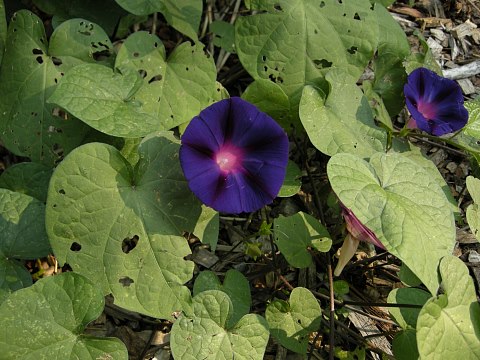Description: This herbaceous vine is a summer annual up to 10' long that branches occasionally. Through its twining stems, Common Morning Glory can climb fences and adjacent vegetation; in open areas, it sprawls across the ground in all directions. The slender stems are terete, light green to brown, slightly to moderately pubescent, and non-woody. At intervals along each stem, there are alternate leaves. The leaf blades are up to 4" long and 3½" across; they are cordate to cordate-orbicular, smooth along their margins, and nearly hairless along their upper surfaces. The slender petioles are nearly as long as the blades; like the stems, they are light green to brown and slightly to moderately pubescent.

Cymes of 1-5
flowers occur at the axils of some leaves. The pedicels of the flowers
are up to 4" long. Each flower is 2–3½" across and about as long; it
consists of a funnelform corolla, 5 sepals, a pistil with a single
style, and 5 stamens. The corolla is purple, blue, pink, white, or a
variegated combination of colors. The light green sepals are
oblong-lanceolate and much smaller than the corolla; they are hairy
toward the bottom of the flower. At the apex of the style is a knobby
tripartite stigma. The blooming period occurs from mid-summer to fall
and lasts 2-3 months. Each flower blooms once during the morning and
lasts only a single day. Each flower is replaced by a globoid seed
capsule about 1/3" (8 mm.) across that is hairless. The large seeds are
dark-colored and wedge-shaped. This plant spreads by reseeding itself.
Cultivation:
The preference is partial to full sunlight and moist to mesic
conditions. Different kinds of soil are tolerated, including those that
are loamy and gravelly. Most growth and development occurs during the
summer. This plant often reseeds itself, but it is less aggressive than
some of the bindweeds (Calystegia, Convolvulus).
Range & Habitat:
Common Morning Glory has naturalized throughout Illinois and wild
plants are encountered occasionally. It appears to be less common in
the NW section of the state. Common Morning Glory was introduced into
North America from
South America as an ornamental plant. Plants with purple flowers appear
to naturalize most often. Habitats include fields, roadsides, gravelly
areas along railroads, fence rows, and waste areas. Relatively open
areas with a history of disturbance are preferred. This plant is still
widely cultivated in gardens and around yards. Depending on the
habitat, a population of naturalized plants can be either fairly
persistent or
ephemeral.
Faunal Associations:
The flowers attract long-tongued bees primarily, especially bumblebees and
long-horned
bees. This includes Squash & Gourd Bees (Peponapis
pruinosa, Xenoglossa strenua), the
Morning Glory Bee (Cemolobus ipomoeae),
and the Mallow Bee (Melitoma taurea). These insects seek nectar from
the flowers primarily (Robertson, 1929; Stucky, 1984). Other
nectar-seeking floral visitors include the Ruby-throated Hummingbird
and White-lined Sphinx (Hyles lineata). Other insects feed
destructively on the foliage, roots, and plant juices of morning glory
vines (Ipomoea spp.). This includes such insects as the Sweet Potato
Flea Beetle (Chaetocnema confinis), Golden Tortoise Beetle
(Charidotella sexpunctata bicolor), Argus Tortoise Beetle (Chelymorpha
cassidea), Morning Glory Leafminer (Bedellia somnulentella), and
larvae of the Morning Glory Plum Moth (Emmelina monodactyla). The Insect Table has a more complete listing of these species. Because both the seeds and foliage of Common Morning Glory
are mildly cathartic and toxic, they are rarely used by vertebrate wildlife as a
source of food. However, the Ring-Necked Pheasant and Bobwhite eat the
seeds to a minor extent (Martin et al., 1951/1961).
Photographic Location:
A garden at Meadowbrook Park in Urbana, Illinois.
Comments:
The short-lived flowers often have a striking appearance because of
their size and rich colors. Common Morning Glory can be distinguished
from other Ipomoea spp. by the color of its flowers
(usually blue, purple, pink, or some combination of these colors with
white) and the shape of its leaves (never lobed). It differs from many
bindweeds (Calystegia & Convolvulus
spp.) by its heart-shaped leaves (cordate); the leaves of
bindweeds are often arrowhead-shaped (sagittate or hastate). Among the
several species in the Bindweed family, the characteristics of the seed
capsules can be useful in making an accurate identification. For
example, the seed capsule of Common Morning Glory is 3-celled and its
exterior surface is hairless, while other species in this plant family
may have seed capsules that are 2-celled or hairy.